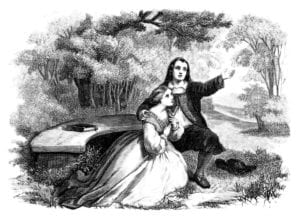Sonnets 18 – 32
Sonnet 18
Summary: Summer is short and all beautiful things live brief lives. But the “fair youth” is different from nature: his beauty is eternal and death will never claim it, since this poem immortalises this beauty and gives it life as long as there are people alive to read the poem.
Note: the seasons were used extensively to connote stages of life in the Procreation Sonnets – for example, Sonnet 1 (“gaudy spring”) and Sonnet 2 (“forty winters”). But the poet no longer asserts the need to bear children in order to achieve immortality, since this is achieved through his art.
Question: is there an element of hyperbole, even perhaps arrogance, in the poet’s claim in the closing couplet?
Sonnet 19
Summary: Time is personified and addressed, licensed by the poet in the opening two quatrains to diminish and destroy as it wishes. But the “heinous crime” of ageing the “fair youth” is to be avoided – though the poet’s verses immortalise his friend’s beauty regardless.
Note: Time is addressed in the intimate form of the second-person, while the “fair youth” is distanced and described objectively in the third person. The double negative in line 10 (“Nor draw no lines …”) gives the poem a conversational ambience.
Question: why is time capitalised in line 13 (“old Time”) but not in line 1?
Sonnet 20
Summary: the fair youth has attractive feminine features alongside many of the virtues associated with women – and few of the alleged defects. As such he appeals to both genders, though having male sex organs suggests he bear children with women, despite the poet’s love for him.
Note: as Time was personified in 19, so Nature here, described as creating this beautiful creature stage by stage, defining their gender last. Contemporary slang references to female (“nothing”) and male (“pricked”) sexual organs lend this sonnet a distinctly salacious tone.
Question: what is the impact of the sexual references on our appreciation of the poem’s key themes?
Sonnet 21
Summary: the poet says he is not like those other writers who routinely exaggerate their lovers’ charms. Improbable comparisons, he says, are not his way, since he can “truly write” about the fair youth’s beauty, and, because he is selling nothing, he does not need to exaggerate.
Note: the poet’s self-proclaimed difference from other writers is reinforced by the plain-speaking, often monosyllabic, tone he adopts in key lines: “So is it not with me” and “O let me true in love”. Underlining his clear delivery is the homespun proverbial wisdom of the closing line.
Question: is the poet being accurate in saying that he is never given to exaggeration?
Sonnet 22
Summary: the poet tells the youth that he will not feel old, so long as their love endures and prospers. They have exchanged hearts, he suggests fancifully, and he will look after his friend’s with no intention of returning it – it was given, after all, “not to give back again”.
Note: though in Sonnet 21 he distances himself from other writers and their alleged dependence on clichés, here the poet describes his affection for the youth in conventional terms: an exchange of hearts. Other familiar metaphors include “furrows” for wrinkles and “nurse” for care-giver.
Question: is line 14 capable of a realistic interpretation? Or is it merely romantic hyperbole?
Sonnet 23
Summary: the poet believes his affection for the fair youth to be so intense as to disable him from expressing it coherently. So his best hope of conveying his love is not in what he says but in what he writes, and the youth must therefore read, rather than hear, the poet’s affectionate messages.
Note: the poet compares himself to an actor whose stage-fright is too overwhelming for him to be able to play his part, so the theatre’s prompt-books, though themselves “dumb”, will better provide the necessary “eloquence” to express his affection than his “tongue”.
Question: for once the poet seems emotionally vulnerable. Identify other sonnets of which this is true.
Sonnet 24
Summary: when the youth gazes into the poet’s eyes, he can see his own beauty reflected there, as if framed or contained in the poet’s bosom. Similarly the poet can see his own reflection in his lover’s eyes. But the mere sight of the youth cannot reflect the depth of the poet’s love for him.
Note: an extended metaphor of painting (“painter … table … frame … perspective … image … art … draw…”) is presented, then abandoned, as being too superficial to convey the depth of affection the poet feels for the fair youth.
Question: how far do you get the impression that the poet’s love for the youth is physically driven?
Sonnet 25
Summary: the poet says he does not envy those who prosper in public life since their eminence depends on the favour of those above them. By contrast, he says, his happiness is assured since it depends on a love that is mutual and secure.
Note: the poem contrasts public life with private. Examples of the former (“public honour … honour … Great princes … glory … warrior … victories” etc) dominate the opening three quatrains. The closing couplet illustrates the balance it praises through its combinations of active and passive verbs.
Question: is this sonnet the most secure we have seen the poet in his relationship with the “fair youth”?
Sonnet 26
Summary: the poet is conscious of his shortcomings with language and “wanting words to show” his devotion to the fair youth. But he hopes his lover may be able to supply “some good conceit” or idea. Till then, though he craves to express his love, he will keep a low profile.
Note: the poet claims he suffers from a lack of linguistic skill, and he may look to reflect this in the uniformly monosyllabic closing couplet. Earlier, two biographical clues suggest that the fair youth is himself a poet and that he may expect to exercise a veto over the publication of these sonnets.
Question: the poet writes out of duty, he says, “not to show my wit”. How convincing is this?
Sonnet 27
Summary: in this sonnet and the next, the poet has been physically exhausted with hard work by day, but night brings no relief since it fills his mind with images of the fair youth. So despite the distance between them, his lover’s image in his mind’s eye makes “black night beauteous”.
Note: the poem is constructed around a series of binary oppositions: work and rest, day and night, dark and light. The poet’s mental image of the fair youth (“like a jewel”) dispels the darkness but allows no rest. Nonetheless the poet’s imagination is actively engaged on its “zealous pilgrimage”.
Question: this poem has a narrative element about it. How unusual is this in these sonnets?
Sonnet 28
Summary: the poet remains exhausted by long days and sleepless nights, spent reflecting on the absence of the fair youth. So though he gives praise for the day being bright when it is gloomy, and for the night when no stars shine, in practice the poet’s grief at the youth’s absence is deepening.
Note: the poet’s sense of helplessness is reflected in the sequence of passive-voiced verbs that open the poem (“am debarred”, “not eased”, “oppressed”). The most prominent contrasting elements in Sonnet 27, day and night, are personified as combining forces to “torture” the poet.
Question: the poet admits to dissembling in the third quatrain. Does this affect our reading of the poem as a whole?
Sonnet 29
Summary: when the poet is in despair – about his mental state, about his appearance, his friendships, his skills and ambitions and a general sense of failure – he imagines the fair youth and his “sweet love”, and abruptly his mood changes and his spirits soar like “the lark”.
Note: the poem pursues a largely literal course through its first two quatrains, in particular in its litany of reasons for the poet’s dissatisfaction (lines 5 to 8), before briefly bursting into metaphor in line 11 (“Like to the lark …”). The closing couplet strikes an emphatic tone, reinforced by the monosyllables of line 14.
Question: how is the metaphor in line 11 appropriate to the poem’s general theme?
Sonnet 30
Summary: the poet reports that there are times when he succumbs to melancholy thoughts, reflecting on past failures, perhaps, lost friends, failed love affairs and other sources of sadness. But when he imagines the fair youth (as Sonnets 27 and 28 describe), his spirits are restored.
Note: the poem’s affirmative concluding couplet is reached via two extended metaphors: initially a quasi-legal spirit is evoked by “sessions … summon up … grievances … “. Thereafter a financial field dominates: “precious … cancelled … expense … account … pay … paid … losses are restored …”.
Question: how appropriate are the metaphorical fields of law and finance to the poem’s theme?
Sonnet 31
Summary: all the love the poet has received in the past is now the due of the fair youth, alongside the love he has to give now. Many friends and lovers have been lost, but the love the poet would have shared with them now belongs to his friend alone, to whom is due “all the all of me”.
Note: images of funeral obsequies are evoked by references to faith (“holy … religious …”) and death (“buried … the dead … the grave … the trophies …”). The closing couplet of this essentially Metaphysical poem may suggest a sexual as well as emotional commitment to the fair youth.
Question: why does the poet use the word “images” for his past lovers in line 13?
Sonnet 32
Summary: the poet imagines his friend reading his sonnets after his own death, and though no doubt they will seem old-fashioned, they should be read for their emotions rather than their quality. Other poets will be more up-to-date, says he speculates, but his poems should be read for their passion.
Note: not for the first time (cf Sonnet 26), the poet believes his poems ill-equipped for purpose. Meanwhile, his preoccupation with his friend’s future, rehearsed in the Procreation Sonnets, now assumes a personal urgency, and the tombs of friends (Sonnet 31) are replaced by an image of the time when “death my bones with dust will cover”.
Question: how far do you think the poet is entitled to suggest that his poems are plain, honest and lacking in ornament and style?
One Hundred Word Endnote:
Shakespeare seems to have composed his 154 sonnets largely for private entertainment, circulated and appreciated among friends. Their existence was first revealed in a book by Francis Meres in 1598, and two were published in 1599, probably without their author’s permission.
The entire collection appeared in 1609, but there the certainties end. The identity of the dedicatee (“Mr W.H.”) is disputed, and anyway he is not necessarily the subject of the poems; at least two lovers are addressed, and probably more than two; and it is highly unlikely the poems were written in the order in which they are printed.




